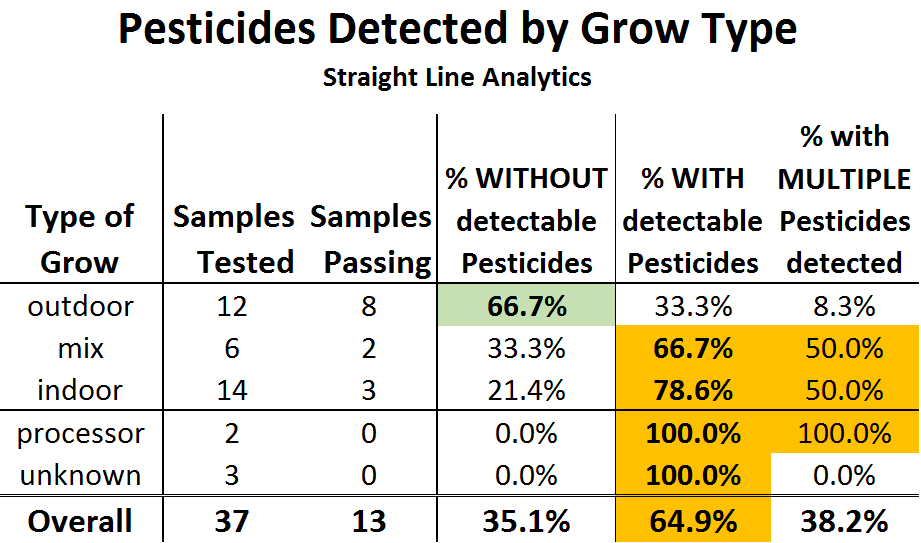Last month, the SLOG reported on a number of Washington Cannabis samples that had been tested for pesticides.
I recently completed an assessment of these test results for a client who has been kind enough to allow me to share some of it with you.
The methodology used was to categorize each of the 36 farms/processors that had product tested into whether their raw material was likely to be Outdoor, Indoor or “Mix”. Numerous inputs were used to classify the grow types.
Outdoor implies product that is primarily lighted by the sun. Indoor implies product that is primarily lighted by lights. Mix implies product that comes from an operation likely using both sources of light. Processor implies a likelihood of product coming from multiple sources. The remaining 3 Unknown entities could not be reliably classified.
In a nutshell, Sungrown product shows fewer instances of detectable pesticides than does Lightgrown product.
It is not “all or none”. One out of three Sungrown products tested had detectable levels of pesticides — but almost 4 out of 5 Lightgrown products had detectable levels of pesticides.
Levels, however, matter (as do the number of pesticides showing up in a given sample and which pesticides are showing up, presumably).
The highest single level reported for Sungrown flower was 353 parts per billion (PPB). The highest for Lightgrown flower was almost 15,000 PPB. (over 40 times more).
When positive, extracts (as one might expect) tended to show higher levels of unauthorized pesticides than did flower (pesticides are like Cannabinoids that way –otherwise they are very different). Multiple Lightgrown samples showed levels in the 10s and 100s of thousands of PPB, whereas the highest level detected in Sungrown extracts was 310 PPB (about a 700-fold difference when compared to200,000+ PPB in the highest Lightgrown result).
Four TLDR takeaways:
-more pesticides are showing up in Lightgrown product than in Sungrown product
-many of the levels showing up are trivial and are likely due to things other than the grower using unauthorized pesticides
-extracts, when testing positive, tend to show higher levels of pesticides than do tests on flower
-processors utilizing multi-sourced product are at increased risk of having positive test results (although the sample used to say this is small, it’s just re-stating the obvious)
Three remaining questions:
How much is too much for any given pesticide? (hint … zero is generally too low a threshold)
Given that some products seem to be making it to market without detectable levels of unauthorized pesticides, how severe should the penalties be for obvious misuse of such substances? How about for apparent repeat offenders?
Is the Sun truly the best pesticide?

I think education could go a long way in mitigating the pesticide issue. Indoor growers need to learn, and utilize, growing techniques, protocols and building design. Unfortunately, many built their structures thinking solely about yield instead of pest prevention or based on “what they have always done”. Education is key.
Right on the money! PAMS needs to be better understood. If it were, folks might truly understand the buildout of their operations is the first integral key to not needing to spray “the bad stuff.” So many operations with unfinished walls, poor air handlers, etc.
The data doesn’t lie, however, I think we need more data input to tell for certain. My instinct is that the sun does play a key role in strengthening the plant’s defense mechanisms. Like Bill Maher. “I don’t know it as fact I just know it to be true.”
So much work to yet be done. The future WA State Cannabis Commission could help immensely!
https://www.ncbi.nlm.nih.gov/pubmed/27045381
even more data that sun grown cannabis is best able to resist disease
Muraco
Thanks , I’ve just been searching for info about this topic for ages and
yours is the greatest I have discovered till now.
But, what about the bottom line? Are you sure
about the source?
Nah … I’m sure of nothing but taxes and death. I am, however, confident in the contents of my post.
“Chain of Custody” can be challenged in all situations (not legally, but rationally).
I have no reason to disbelieve my interpretation of the data. When “they” were lookin’ for pesticides, “they” had no systematic foreknowledge of the indoor/outdoor grow status of the product being tested.
The argument can be made for labs wanting to report positives to pump up regulatory opinion on the need for expensive mandatory testing.
Arguments can also be made that the person or people behind collecting these samples and having them tested might be batshit-crazy (or whatever demeaning label is conveniently dusted off and pulled from the shelf to apply to their apparently civic-minded asses) …. and that, in the way batshit-crazy folk tend to do, they have let their hallucinatory realities impinge upon objective random sampling and/or other links on the chain of custody highway.
Bottom line … small sample size, but rather suggestive results. Interesting work. Worthy of further study (Funding Entities take note …. I’d do it for the right payola — but I’m not currently affiliated by one of the Universities beholden to the Feds for funding).